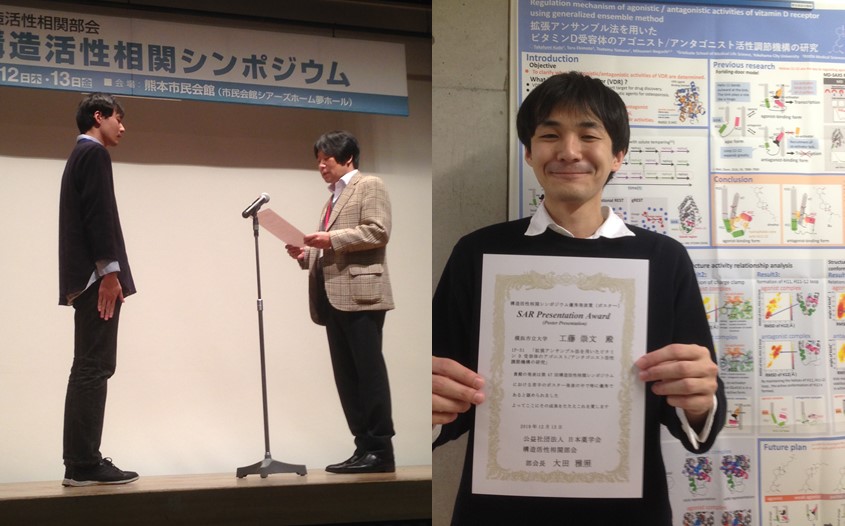生命医科学研究科博士前期課程2年工藤崇文さん、構造活性相関シンポジウムでSAR presentation awardを受賞!
2019.12.18
- TOPICS
- 研究
- 学生の活躍
- 教育
- 大学
生命情報科学研究室博士前期課程2年工藤崇文さん、構造活性相関シンポジウムでSAR presentation award(ポスター)を受賞!

発表演題「Regulation mechanism of agonistic/antagonistic activities of vitamin D receptor using generalized ensemble method」
生命情報科学研究室博士前期課程2年の工藤崇文(指導教員:池口満徳教授)さんは、2019年12月12日(木)〜13日(金)に熊本市民会館(熊本県)で開催された第47回構造活性相関シンポジウムにおいてポスター発表を行い、SAR presentation award(ポスター)を受賞されました
工藤崇文さんのコメント
この度は名誉ある賞をいただき、大変ありがたく思います。
池口教授をはじめ、熱心にご指導いただいた生命情報科学研究室の皆様に心より感謝申し上げます。
発表当日はX線結晶解析回折や核内受容体の専門家の方々から数多くのご助言をいただきました。
自分一人では気付くことができなかった視点や改善点についてご指摘をいただいたことから、自分の未熟さを改めて痛感いたしました。
本シンポジウムを通した貴重な経験を活かして、残りの研究生活をより一層精進していきたいと思います。
受賞者コメントはSAR News38 (2020年4月)に掲載予定
池口教授をはじめ、熱心にご指導いただいた生命情報科学研究室の皆様に心より感謝申し上げます。
発表当日はX線結晶解析回折や核内受容体の専門家の方々から数多くのご助言をいただきました。
自分一人では気付くことができなかった視点や改善点についてご指摘をいただいたことから、自分の未熟さを改めて痛感いたしました。
本シンポジウムを通した貴重な経験を活かして、残りの研究生活をより一層精進していきたいと思います。
受賞者コメントはSAR News38 (2020年4月)に掲載予定
指導教員の池口満徳教授のコメント
工藤さんは、日本生物物理学会での学生発表賞に続き、2度目の受賞ですね。おめでとうございます。
前回の日本生物物理学会の参加者とは、今回の日本薬学会構造活性相関部会の参加者は結構異なると思いますので、いろいろな分野の方に評価されたということになります。これも日頃の熱心な研究の成果だと思います。
大学院学生生活も後少しです。修士論文をしっかりまとめて、立派な社会人として羽ばたいてください!
前回の日本生物物理学会の参加者とは、今回の日本薬学会構造活性相関部会の参加者は結構異なると思いますので、いろいろな分野の方に評価されたということになります。これも日頃の熱心な研究の成果だと思います。
大学院学生生活も後少しです。修士論文をしっかりまとめて、立派な社会人として羽ばたいてください!
発表内容
1. Introduction
Vitamin D receptor (VDR) is one of the nuclear receptors (NR) and an important target for drug discovery. For example, VDR agonists are clinically applied as therapeutic agents for osteoporosis. VDR antagonists are expected as therapeutic agents for marble bone disease. According to X-ray crystallography of other NRs and experimental results, the ligand-binding domain (LBD) undergoes the conformational change upon a ligand binding, and a local conformational change around helix 12 is key to regulating agonistic/antagonistic activities. However, since the crystal structures of agonist and antagonist complexes of VDR-LBD were almost identical, it is difficult to discuss the differences of their activities based on the crystal structures. In order to clarify the regulation mechanism of agonistic/antagonistic activities of VDR ligands, molecular dynamics (MD) simulations for VDR-LBD were performed.
2. Methods
Because of the limited time scale of the conventional MD simulations, the structure is trapped in the local minimum and cannot overcome the energy barrier, so it was difficult to observe large conformational changes. Therefore, gREST(1), one of the generalized ensemble methods, was employed for the efficient conformational sampling of VDR-LBD.
3. Results and Discussion
In the gREST simulations, spontaneous ligand-dependent conformational changes of VDR were observed, the differences of agonistic/antagonistic activities were detected. A typical conformation of the antagonist bound form has a similar feature to that observed by MD-SAXS hybrid approach(2). By using this method, spontaneous conformational changes may be captured even if there are only crystal structures of active form. In the future, we expect to be able to discuss the structure-activity relationship of VDR in detail by performing simulations on ligands with different activities such as partial agonists and inverse agonists.
4. Acknowledgment
This research used computational resources of the K computer provided by the RIKEN Center for Computational Science.
5. References
(1)Kamiya, M., Sugita Y., J. Chem. Phys., 149, 072304-1-11, 2018
(2) Anami, Y., Shimizu, N., Ekimoto, T., Egawa, D., Itoh, T., Ikeguchi, M., Yamanoto, K., J. Med. Chem., 59, 7888-7900, 2016.
Vitamin D receptor (VDR) is one of the nuclear receptors (NR) and an important target for drug discovery. For example, VDR agonists are clinically applied as therapeutic agents for osteoporosis. VDR antagonists are expected as therapeutic agents for marble bone disease. According to X-ray crystallography of other NRs and experimental results, the ligand-binding domain (LBD) undergoes the conformational change upon a ligand binding, and a local conformational change around helix 12 is key to regulating agonistic/antagonistic activities. However, since the crystal structures of agonist and antagonist complexes of VDR-LBD were almost identical, it is difficult to discuss the differences of their activities based on the crystal structures. In order to clarify the regulation mechanism of agonistic/antagonistic activities of VDR ligands, molecular dynamics (MD) simulations for VDR-LBD were performed.
2. Methods
Because of the limited time scale of the conventional MD simulations, the structure is trapped in the local minimum and cannot overcome the energy barrier, so it was difficult to observe large conformational changes. Therefore, gREST(1), one of the generalized ensemble methods, was employed for the efficient conformational sampling of VDR-LBD.
3. Results and Discussion
In the gREST simulations, spontaneous ligand-dependent conformational changes of VDR were observed, the differences of agonistic/antagonistic activities were detected. A typical conformation of the antagonist bound form has a similar feature to that observed by MD-SAXS hybrid approach(2). By using this method, spontaneous conformational changes may be captured even if there are only crystal structures of active form. In the future, we expect to be able to discuss the structure-activity relationship of VDR in detail by performing simulations on ligands with different activities such as partial agonists and inverse agonists.
4. Acknowledgment
This research used computational resources of the K computer provided by the RIKEN Center for Computational Science.
5. References
(1)Kamiya, M., Sugita Y., J. Chem. Phys., 149, 072304-1-11, 2018
(2) Anami, Y., Shimizu, N., Ekimoto, T., Egawa, D., Itoh, T., Ikeguchi, M., Yamanoto, K., J. Med. Chem., 59, 7888-7900, 2016.


